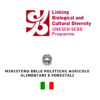1st European Conference for the Implementation of the UNESCO-SCBD Joint Programme on Biological and Cultural Diversity
8-11 April 2014, Florence, Italy
Introduction
Recognizing the inextricable link between biological and cultural diversity, the United Nations Educational Scientific and Cultural Organization (UNESCO) and the Secretariat of the Convention on Biological Diversity (SCBD) joined forces to raise awareness of the importance of the interactions between biological and cultural diversity for global sustainability. With the CBD acting as global focal point for biodiversity and UNESCO acting as global focal point for cultural diversity, the two institutions launched in 2010 the Joint Programme on the Links between Biological and Cultural Diversity (JP-BiCuD) to strengthen the linkages between biological and cultural diversity initiatives, and enhance the synergies between interlinked provisions of conventions and programmes dealing with biological and cultural diversity at relevant scales.
In 2014, in the context of JP-BiCuD, a series of regional workshops and conferences will be organized in Europe and North America, Asia and the Pacific, Arab region, Africa and Latin America an the Caribbean. The first conference will take place in Florence, Italy, to address the links between biological and cultural diversity from the European perspective.
Concept
The scientific and policy dimensions of JP-BiCuD are of utmost importance in the European context where cultural, environmental and rural policies are devoted to the conservation of biodiversity and cultural heritage, but rarely focused on the interactions between nature and culture. Yet, throughout European history, the outcomes of such interactions, including through traditional farming and forestry practices, have been critical for creating resilient landscape patterns, diversifying biological and cultural resources and shaping cultural identity of different European regions.
Several international scientific organizations and the United Nations have designated landscape as one of the primary concerns of upcoming sustainability policies. The quality of European landscapes and the associated quality of life is determined by the tight interplay between their economic, social and cultural aspects, through time and space and is often grounded in specific landscapes features. The preservation of such features contributes towards higher quality of life for local populations through material and immaterial means. These features improve people’s lives and contribute to local economy while fulfilling their recreational, emotional and spiritual needs, and their sense of identity. Conservation of complex landscape patterns that reflect the identity of different regions, their historical management practices and related biological and cultural diversity need to be ensured through integrated planning and management strategies also as a way of adapting to change. It is also important to develop integrated strategies that will engage public, owners and local administrations for the recovery, preservation and maintenance of the linkages between cultural and biological diversity reconnecting rural to urban areas and contributing to the well being of the entire population.
More research focusing on the links between cultural and biological diversity at the landscape level is also needed. This is an important task as these links, have been rarely formalized from a scientific perspective, therefore knowledge about them has often been ignored or lost. This has led not only to a separation between nature and culture in policies, but also between science and humanities in the study and management of natural and cultural values, affecting the conservation of cultural heritage as well as the natural heritage.
Key Topics
- Interactions between cultural and biological diversity and identification of linkages between cultural and biological diversity in the European context
- Historical development of biodiversity patterns associated with “natural” and “cultural” landscapes, including the interacting actors, factors and processes
- Traditional agricultural and forest management practices related to bio-cultural diversity
- Development of methods and approaches for the assessment of the links between biological and cultural diversity and the resulting “bio-cultural” diversity
- Development of integrated management strategies at landscape level
- Implementation of international, regional and national agreements dealing with cultural and biological diversity
Expected Outcomes
- Identification of policy areas relevant for mainstreaming the links between biological and cultural diversity in Europe
- Formulation of a joint position and strategy for linking biological and cultural diversity in the region
- Identification of relevant actors in the region and their role in implementation of the joint strategy
Organizers
UNESCO, S-CBD; Italian Ministry of Agriculture, Food, and Forestry Policies; Tuscan Region; Laboratory for Landscape and Cultural Heritage of the University of Florence
Conference secretariat
landscape@unifi.it; Laboratory for Landscape and Cultural Heritage – Department of Agricultural, Food and Forestry Systems – University of Florence




